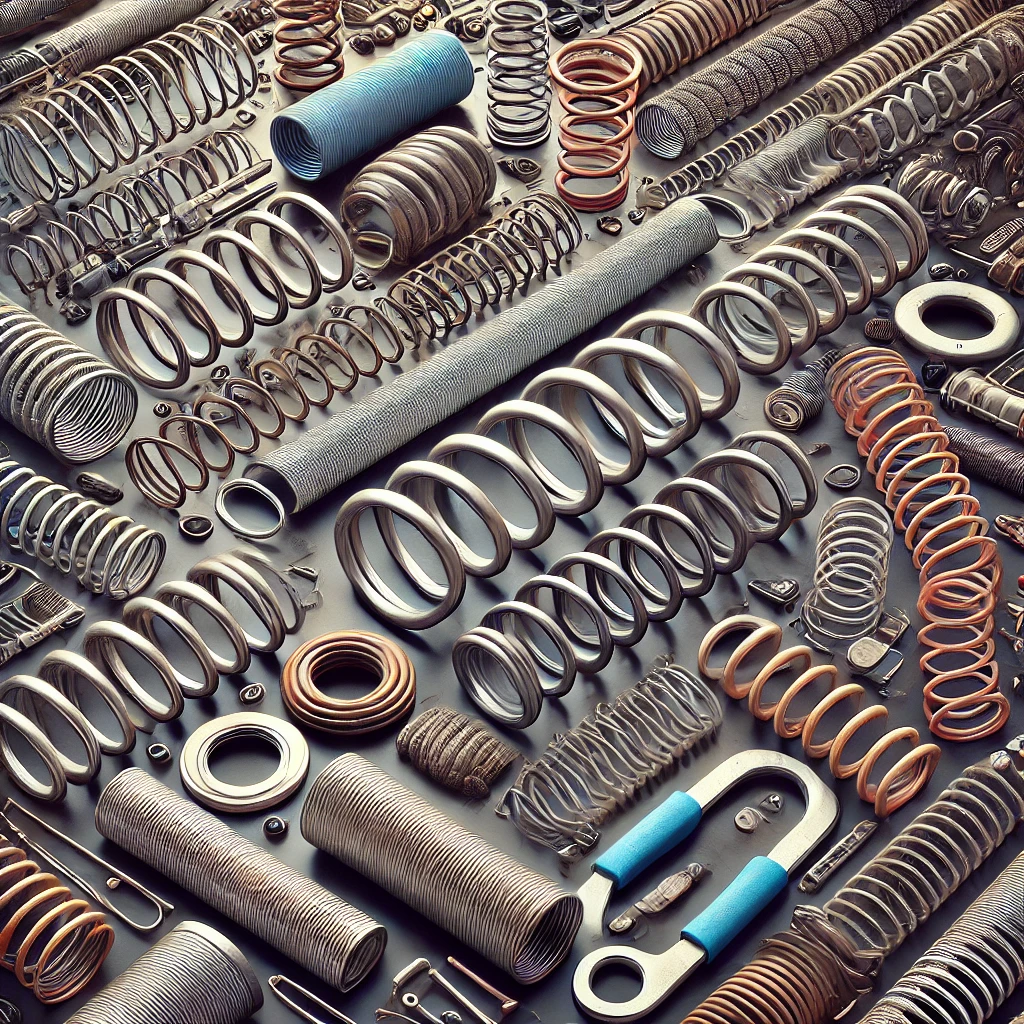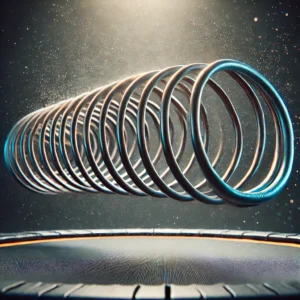The Backbone of Your Bouncing Experience
Ever wondered what really makes a trampoline give you that exhilarating bounce? The answer lies not in the mat itself, but in those coiled metal pieces surrounding it – the trampoline springs. These seemingly simple components are actually engineering marvels that transform your downward pressure into upward propulsion, creating that weightless feeling we all love.
When I first started researching trampoline springs for my family’s backyard setup, I was amazed at how much these humble coils impact the overall bouncing experience. In fact, trampoline springs are the unsung heroes of your outdoor fun, determining everything from bounce quality to safety and longevity.
Whether you’re a trampoline enthusiast looking to upgrade your current setup or a concerned parent wanting to ensure your children’s safety, understanding trampoline springs is essential. Throughout this comprehensive guide, we’ll dive deep into the world of trampoline springs, covering everything from how they work to how to choose the right ones for your needs.
The Science Behind Trampoline Springs ⚡
How Trampoline Springs Work
At their core, trampoline springs operate on a fundamental principle of physics. When you jump on a trampoline, your body weight compresses the springs, storing potential energy. As the springs return to their original shape, they release this stored energy, propelling you upward. This transfer of energy is what gives trampolines their bounce.
Trampoline springs are typically made from galvanized steel, which offers a perfect balance of flexibility, durability, and resistance to corrosion. The material choice is crucial because these springs need to withstand thousands of compression cycles while being exposed to the elements.
Types of Trampoline Springs
Not all trampoline springs are created equal. There are several types you might encounter:
✅ Standard Coil Springs: These are the most common type, featuring a uniform coil pattern that provides consistent bounce.
✅ Tapered Springs: These springs have a varying coil diameter, which can create a more progressive bounce feel.
✅ Cone-shaped Springs: Growing in popularity, these provide a softer initial bounce but firm up as compression increases.
Each type has its advantages, and the right choice depends on the intended use of your trampoline. For recreational family use, standard coil springs often provide the best balance of performance and durability. However, if you’re looking for a professional-grade bounce for gymnastics or other sports, tapered or cone-shaped springs might be more appropriate.
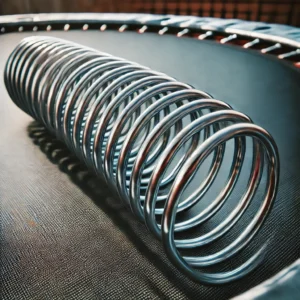
Choosing the Right Trampoline Springs
Understanding Spring Measurements
When shopping for trampoline springs, you’ll encounter several key measurements:
- Length: This is measured from hook to hook and typically ranges from 5.5 to 8.5 inches for residential trampolines. Length directly affects the bounce quality – longer springs generally provide a deeper, more gentle bounce.
- Gauge: This refers to the thickness of the wire used to make the spring. Higher gauge numbers indicate thinner wire, while lower numbers mean thicker, stronger wire. Most quality residential trampolines use springs with a gauge between 3.2 and 3.5 mm.
- Coil Count: This is the number of coils in the spring. More coils generally mean more potential energy storage, which can translate to a better bounce. However, this also depends on the coil diameter and wire gauge.
Matching Springs to Your Trampoline
One of the most common mistakes people make is purchasing replacement springs without checking compatibility. To ensure you get the right springs, consider:
- Manufacturer Specifications: Always refer to your trampoline’s manual or manufacturer’s website for recommended spring specifications.
- Trampoline Size: Larger trampolines typically require more springs or longer springs to distribute the load properly.
- Weight Capacity: If you’re upgrading your trampoline for heavier users, you might need stronger springs with a higher gauge.
Quality Indicators
When evaluating trampoline springs, look for these signs of quality:
✅ Galvanization: High-quality springs should be hot-dip galvanized to prevent rust and corrosion. ✅ Uniform Coils: The coils should be evenly spaced with no irregularities. ✅ Strong Hooks: The hooks at each end should be solid and properly formed. ✅ Proper Tensioning: When installed, the springs should provide uniform tension around the entire trampoline.
Top Trampoline Springs on the Market
After extensive research and testing, I’ve identified some of the best trampoline springs currently available on Amazon. These options offer excellent performance, durability, and value for money.
Premium Option for Maximum Durability
For those seeking the absolute best in terms of longevity and performance, the SkyBound Premium Trampoline Replacement Springs stand out. These heavy-duty springs feature enhanced galvanization and are designed to withstand harsh weather conditions. They come in various lengths to fit most trampoline models and offer a noticeably improved bounce compared to standard springs.
Best Value for Regular Replacement
If you’re looking for a cost-effective solution that doesn’t compromise on quality, the Upper Bounce Trampoline Springs provide exceptional value. These springs come in packs of various quantities, making them perfect for both full replacements and spot repairs. They feature a standard gauge that works well for most family trampolines.
Best for Heavy-Duty Use
For trampolines that see frequent use by multiple jumpers or heavier individuals, the Skywalker Trampoline Heavy-Duty Replacement Springs offer extra strength and durability. These springs have a thicker gauge and additional coils, allowing them to support more weight without losing their bounce characteristics.
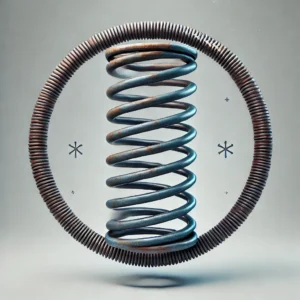
Comparison Table: Top Trampoline Springs
| Product | Length | Gauge | Pack Size | Weather Resistance | Price Range |
|---|---|---|---|---|---|
| SkyBound Premium | 5.5″ – 8.5″ | 3.2mm | 10-120 | Excellent | $$$$ |
| Upper Bounce | 5.5″ – 7″ | 3.4mm | 15-96 | Very Good | $$ |
| Skywalker Heavy-Duty | 5.5″ – 7.5″ | 3.0mm | 8-64 | Excellent | $$$ |
| Jumpking Galvanized | 5.5″ – 7″ | 3.4mm | 12-72 | Good | $$ |
| AGame Trampoline Springs | 7″ – 8.5″ | 3.2mm | 12-48 | Very Good | $$$ |
Ready to upgrade your trampoline’s performance? Click any of the product links above to check current prices and availability. Your perfect bounce is just a spring replacement away!
Installation and Maintenance of Trampoline Springs
Proper Installation Techniques
Installing trampoline springs correctly is crucial for both safety and performance. Follow these steps for a proper installation:
- Preparation: Lay out all springs and ensure you have the correct number and size.
- Initial Placement: Install springs at four equidistant points around the trampoline (think of a compass: north, south, east, west).
- Balanced Tension: Continue adding springs in a pattern that maintains even tension. Never install all springs on one side before moving to the other.
- Using Tools: A spring puller tool can make installation much easier and safer. The Trampoline Pro Spring Puller Tool is an excellent choice for this purpose.
Safety Precautions During Installation
Working with trampoline springs can be dangerous if proper precautions aren’t taken:
- Always wear gloves to protect your hands from pinching.
- Use safety glasses to protect your eyes from potential spring recoil.
- Keep children away from the work area during installation.
- Never stand directly in the path of a spring being stretched.
Regular Maintenance for Longevity
To maximize the lifespan of your trampoline springs:
✅ Regular Inspection: Check springs at least monthly during the active season for signs of wear, rust, or stretching. ✅ Cleaning: Remove debris that might get caught in the springs and cause premature wear. ✅ Rust Prevention: Apply a light coat of silicone spray to springs periodically to prevent rust formation. ✅ Winter Care: In colder climates, consider removing the springs and storing them indoors during winter months when the trampoline isn’t in use.
Common Trampoline Spring Problems and Solutions ️
Identifying When Springs Need Replacement
Several signs indicate it’s time to replace your trampoline springs:
- Visible Stretching: If springs appear significantly longer than when new, they’ve lost their elasticity.
- Rust Formation: Rust weakens the metal and can lead to breakage.
- Gaps in the Spring Pattern: Missing or broken springs create uneven tension and unsafe bouncing conditions.
- Reduced Bounce Quality: If your trampoline doesn’t bounce as high as it used to, worn springs might be the culprit.
Troubleshooting Specific Issues
| Problem | Possible Cause | Solution |
|---|---|---|
| Squeaking Springs | Friction between coils | Apply silicone spray lubricant |
| Uneven Bounce | Inconsistent spring tension | Check for stretched or broken springs and replace as needed |
| Rust Formation | Exposure to moisture | Clean with vinegar solution, rinse, dry, and apply rust inhibitor |
| Spring Breakage | Overloading or age | Replace broken springs immediately to prevent uneven tension |
| Detached Springs | Improper installation or wear | Reinstall with proper tools and techniques |
When to Replace All Springs vs. Individual Replacement
While replacing individual springs as they break is more economical in the short term, there are situations when replacing all springs simultaneously makes more sense:
- When more than 25% of springs show signs of wear or rust
- When the trampoline is more than 3-5 years old
- When upgrading to a different type of spring for improved performance
- When multiple springs have broken in a short period (indicating general fatigue)
A complete replacement ensures consistent bounce quality and can actually be more cost-effective in the long run. The Upper Bounce Complete Trampoline Spring Set offers an excellent all-in-one solution for full replacements.
The Impact of Springs on Trampoline Safety ️
How Springs Affect Jumping Safety
Trampoline springs play a critical role in user safety in several ways:
- Energy Absorption: Properly functioning springs absorb and redistribute energy, reducing the risk of injury from hard landings.
- Bounce Consistency: Even tension around the trampoline provides predictable bounce, allowing jumpers to maintain control.
- Edge Protection: Springs create a buffer zone between the jumping surface and the hard frame.
Spring Covers and Safety Pads
While springs themselves are important for safety, they also pose pinch and fall hazards. That’s why proper covering is essential:
✅ Spring Covers: These sleeve-like covers wrap individual springs to prevent pinching. ✅ Safety Pads: These cover the entire spring area and provide cushioning if a jumper lands on the edge.
For optimal safety, consider the Trampoline Pro Premium Safety Pad, which offers excellent coverage and durability to protect jumpers from spring-related injuries.
Weight Limits and Spring Specifications
Understanding the relationship between weight limits and spring specifications is crucial for safety:
- Exceeding weight limits can overextend springs, leading to premature failure.
- Different spring types have different weight capacities.
- Adding more springs doesn’t necessarily increase weight capacity if the frame isn’t designed for it.
Always adhere to manufacturer weight guidelines and consider upgrading to heavy-duty springs if your trampoline regularly accommodates users near its weight limit.
Upgrading Your Trampoline Springs for Better Performance
When to Consider an Upgrade
Upgrading your trampoline springs can significantly improve your bouncing experience. Consider upgrading when:
- You want a higher bounce for athletic training.
- Your current springs provide inconsistent performance.
- You need to accommodate heavier users.
- You’re looking to extend the lifespan of your trampoline.
Performance Improvements from Spring Upgrades
Different spring upgrades can yield different benefits:
- Longer Springs: Increase bounce height and provide a softer landing.
- Heavier Gauge: Improve durability and support for heavier users.
- Higher Coil Count: Enhance energy storage for a more responsive bounce.
- Tapered Design: Create a more progressive bounce feel.
Cost-Benefit Analysis of Upgrading
When considering an upgrade, weigh these factors:
- Cost of new springs vs. cost of a new trampoline
- Expected lifespan extension
- Performance improvements
- Safety enhancements
For many trampolines, a spring upgrade can add years of life at a fraction of the cost of replacement. The SkyBound Premium Performance Springs offer an excellent upgrade option that balances cost with significant performance improvements.
DIY Spring Replacement Guide
Tools You’ll Need
Gathering the right tools before starting makes the job much easier:
- Spring puller tool
- Protective gloves
- Safety glasses
- Measuring tape
- Lubricant spray
- Rust inhibitor (optional)
Step-by-Step Replacement Process
- Count and Measure: Confirm the number and length of springs needed.
- Remove Old Springs: Using the spring puller, carefully remove old springs. Work in a pattern to maintain balance.
- Clean the Frame: Remove any rust or debris from the frame holes.
- Install New Springs: Following the balanced tension pattern described earlier, install new springs.
- Test and Adjust: Check for even tension and make adjustments as needed.
Tips for Ensuring Even Tension
- Use a reference spring to compare tension as you install.
- Listen for consistent pitch when tapping installed springs.
- Visually inspect for uniform stretching around the perimeter.
Seasonal Care for Trampoline Springs ️
Spring Maintenance Through the Seasons
Different seasons present different challenges for trampoline springs:
Spring/Summer Care:
- Check for winter damage and replace affected springs.
- Apply rust inhibitor before heavy use season begins.
- Inspect springs more frequently during peak usage.
Fall Preparation:
- Clean springs thoroughly to remove summer debris.
- Apply protective lubricant before wet weather.
- Consider a trampoline cover to extend spring life.
Winter Protection:
- In severe climates, removing springs and storing them indoors is ideal.
- If removal isn’t practical, use a weatherproof cover like the Skywalker Trampolines Weather Cover.
- Regularly remove snow accumulation to prevent spring stretching.
Storage Solutions for Off-Season
If you choose to remove springs during the off-season:
- Clean and dry springs thoroughly before storage.
- Apply a light coat of oil or silicone spray.
- Store in a dry, climate-controlled environment.
- Keep springs organized to maintain their shape.
Frequently Asked Questions About Trampoline Springs ❓
How often should trampoline springs be replaced?
Under normal use, quality trampoline springs typically last 2-5 years. However, factors like weather exposure, frequency of use, and jumper weight can significantly impact lifespan. Regular inspection is the best way to determine when replacement is necessary.
Can I mix different spring lengths on my trampoline?
While it’s technically possible, mixing spring lengths creates uneven tension and can lead to unpredictable bounce patterns and increased wear on both the springs and the trampoline mat. It’s best to use uniform springs as recommended by the manufacturer.
How many springs does my trampoline need?
The number of springs depends on the size and model of your trampoline:
- 8ft trampolines typically use 48-64 springs
- 10ft trampolines typically use 64-72 springs
- 12ft trampolines typically use 72-96 springs
- 14ft and larger trampolines may use 96-120 springs
Always consult your manual or the manufacturer’s website for the exact number recommended for your model.
Are longer springs better for trampolines?
Longer springs generally provide a deeper, more forgiving bounce with greater height potential. However, they also require more space between the frame and the mat. The “better” spring length depends on your specific needs and the design of your trampoline.
Can I use spring extenders to improve bounce?
Spring extenders can increase bounce height by effectively lengthening the springs. However, they can also create additional stress on the frame and springs. If considering extenders, ensure your trampoline frame is sturdy enough to handle the increased stress.
Expert Tips for Trampoline Spring Enthusiasts
Maximizing Bounce Quality
To get the most out of your trampoline springs:
- Maintain Even Tension: Regularly check and adjust spring tension to ensure consistency.
- Clean Springs Regularly: Remove debris that can interfere with spring function.
- Consider Your Jumping Style: Different spring types favor different jumping styles.
- Upgrade Strategically: Focus upgrades on areas that will most benefit your particular use.
Finding the Right Balance for Your Needs
The perfect spring setup depends on your priorities:
- For young children: Softer, more forgiving springs
- For teenage users: Standard springs with good responsiveness
- For athletic training: Longer, more responsive springs
- For mixed family use: Medium-length springs with durable construction
Professional vs. Recreational Considerations
Professional trampolinists have different needs than recreational users:
- Professional: Emphasis on consistent bounce characteristics and precise energy return
- Recreational: Focus on durability, safety, and general bounce quality
For those seeking professional-grade springs, the SkyBound Olympic Trampoline Springs offer competition-level performance, though at a higher price point than standard options.
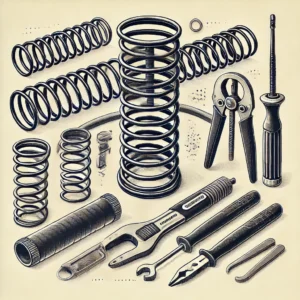
Conclusion: Springing Forward with Confidence
Trampoline springs may seem like simple components, but as we’ve explored throughout this guide, they’re sophisticated elements that significantly impact your trampoline experience. From safety and performance to longevity and maintenance, understanding trampoline springs empowers you to make informed decisions about your equipment.
Whether you’re replacing worn springs, upgrading for better performance, or simply maintaining your current setup, the knowledge you’ve gained here will help ensure your trampoline provides years of safe, enjoyable bouncing. Remember that regular inspection and maintenance are key to extending the life of your springs and protecting your investment.
By selecting the right springs, installing them properly, and caring for them diligently, you’re not just maintaining a piece of equipment – you’re preserving a source of joy, exercise, and family fun for years to come.
Ready to transform your trampoline experience? Don’t wait until your springs fail – check out the recommended products in this guide and give your trampoline the upgrade it deserves. Your future self (and your happily bouncing family) will thank you!
More FQAs:
❓ How do trampoline springs impact bounce quality?
✅ Trampoline springs store and release energy during jumps, directly influencing the height and softness of the bounce...
❓ What materials are trampoline springs typically made from?
✅ Most trampoline springs are crafted from galvanized steel, offering durability and resistance to corrosion...
❓ How does spring length affect trampoline performance?
✅ Longer springs generally provide a deeper, more gentle bounce, while shorter springs offer a tighter, more responsive bounce...
❓ Why is it important to match spring specifications to your trampoline?
✅ Ensuring springs match your trampoline's design maintains optimal performance and safety, preventing structural issues...
❓ What are the signs of high-quality trampoline springs?
✅ Indicators include hot-dip galvanization, uniform coils, strong hooks, and proper tensioning...
Recommended for You:
- Trampoline Games: 25+ Fun Activities for Family Fitness & Epic Backyard Entertainment
- Best Trampoline Basketball Goal 2025: Turn Your Backyard into an Epic Dunk Zone!
- The Ultimate Guide to Square Trampolines: Why They’re the Perfect Backyard Addition in 2025
Disclaimer: This article contains affiliate links. If you purchase products through these links, we may earn a small commission at no additional cost to you.
